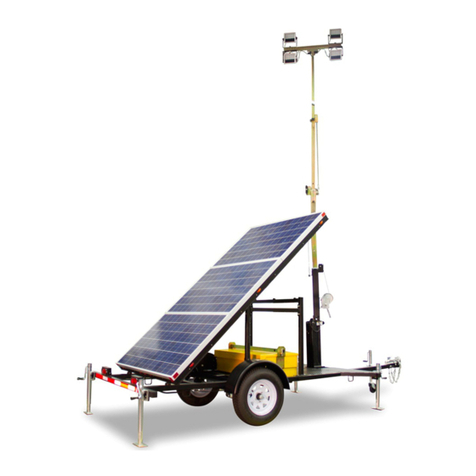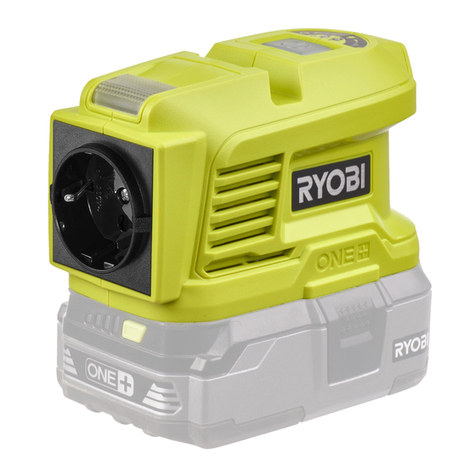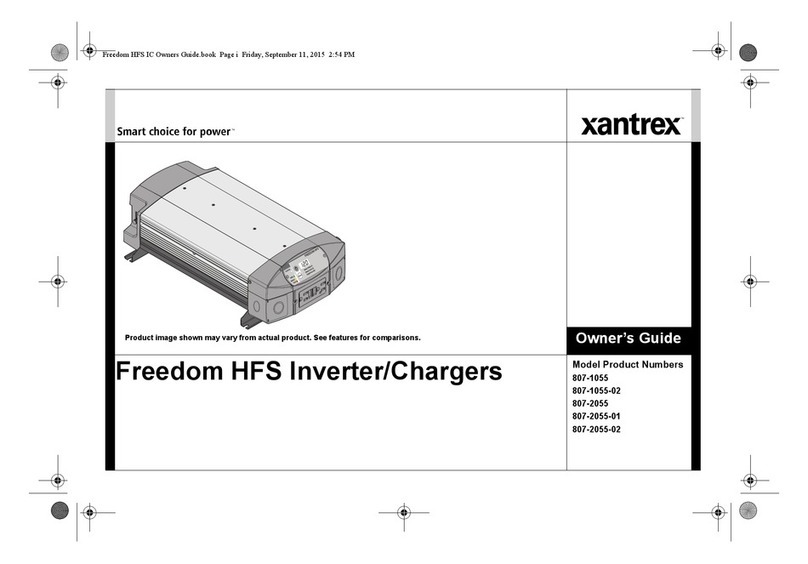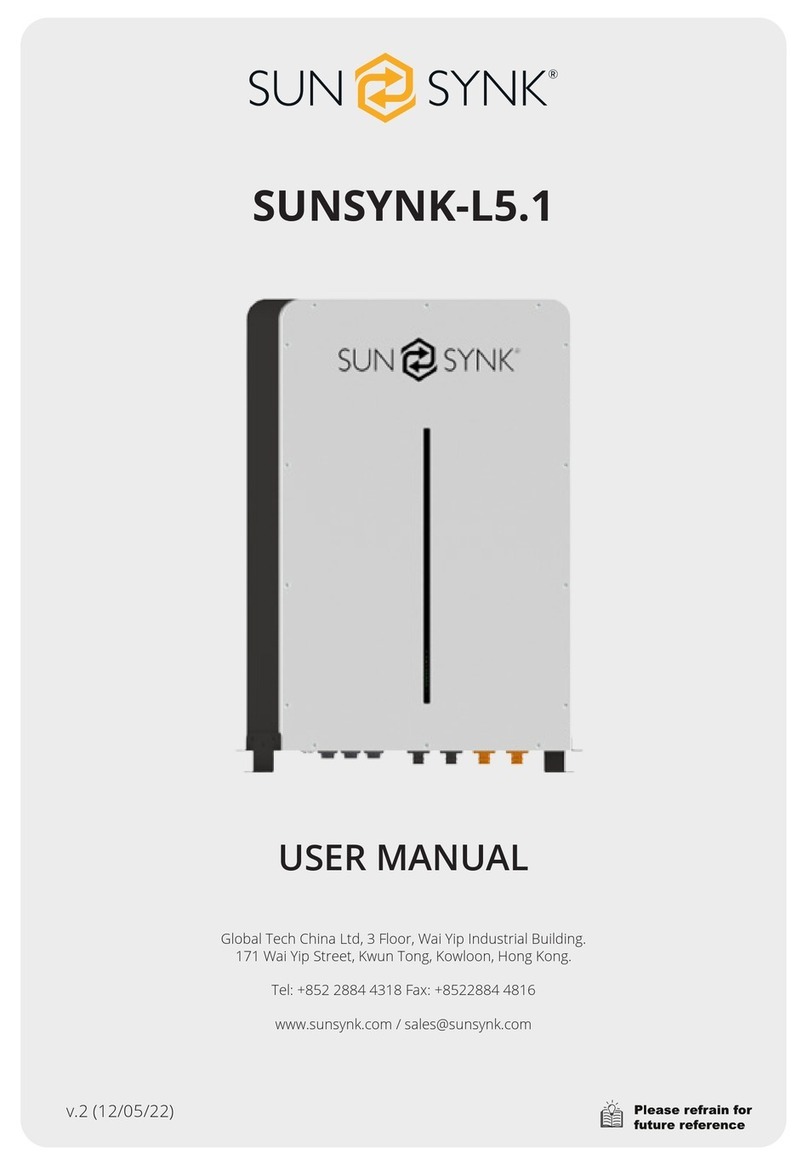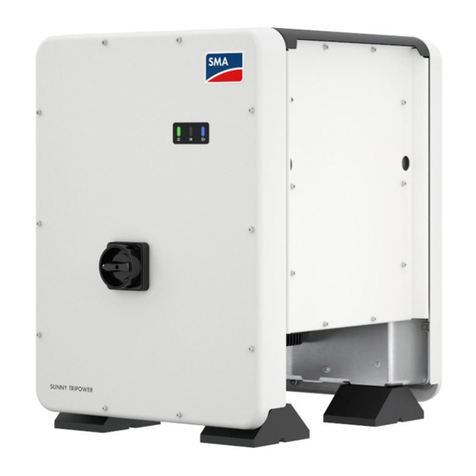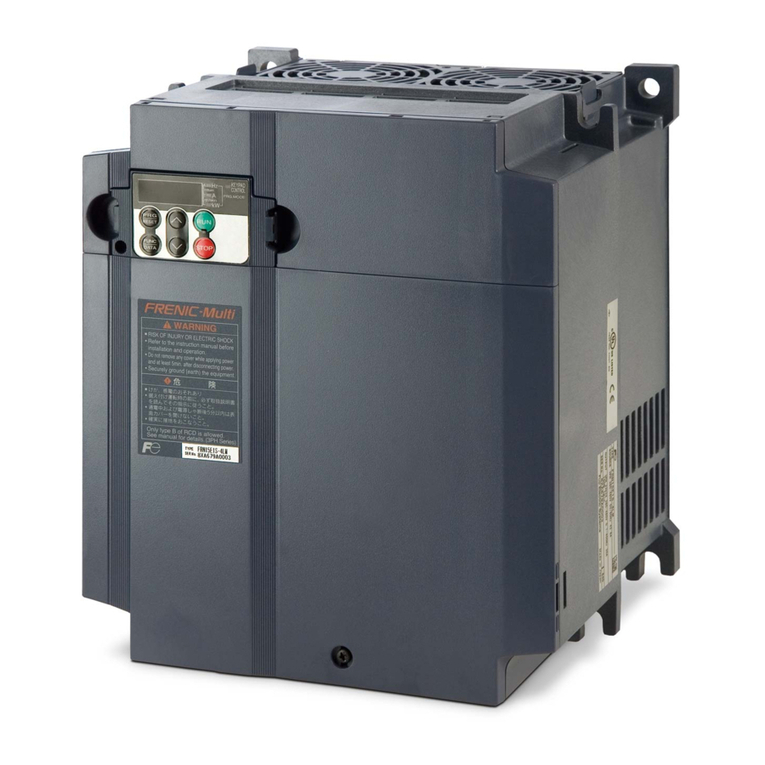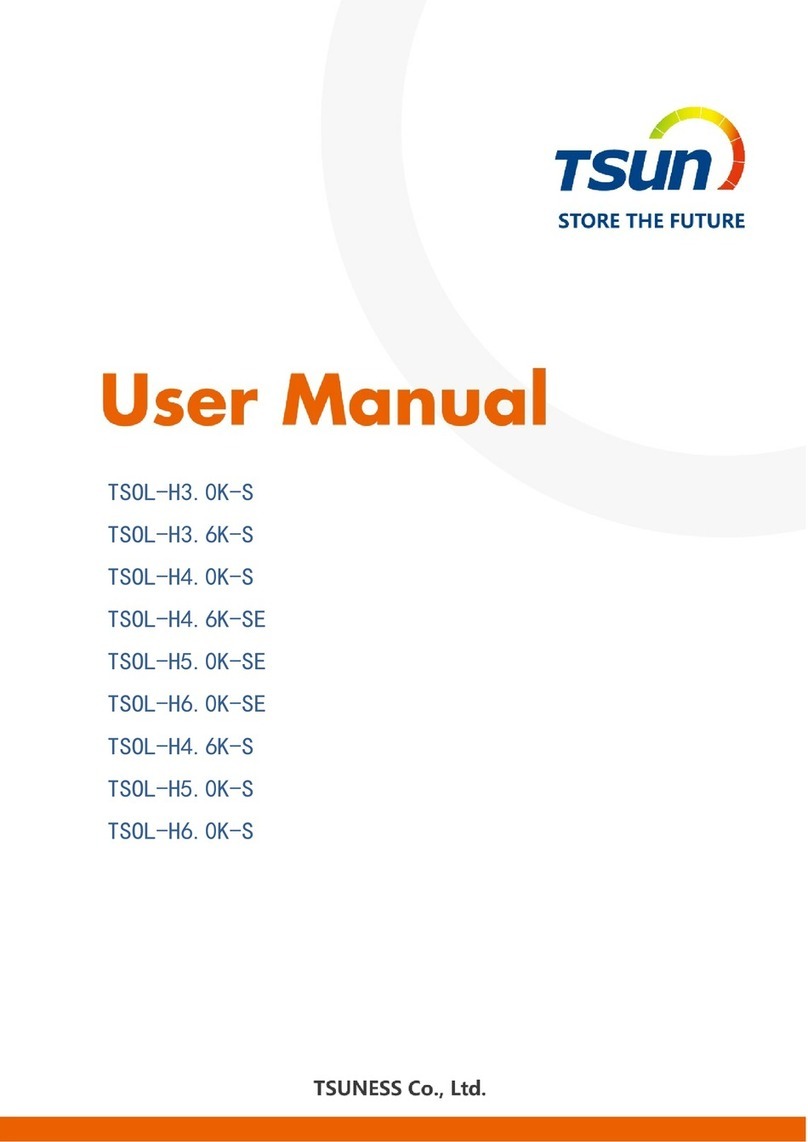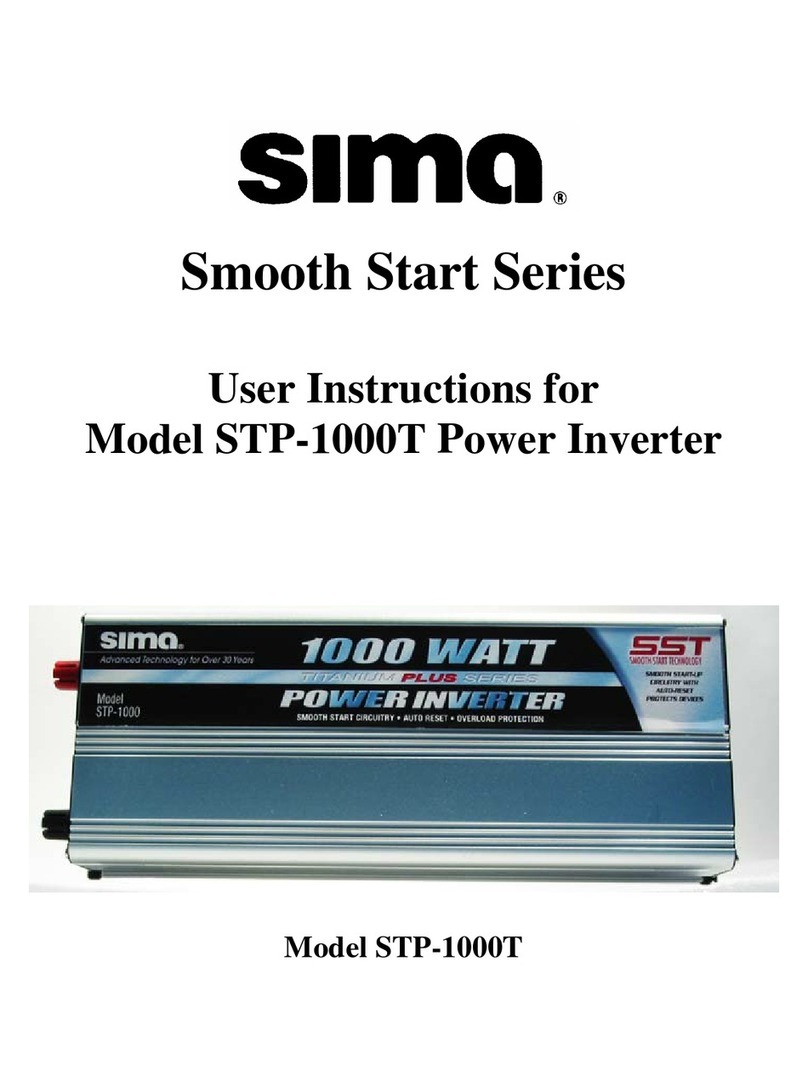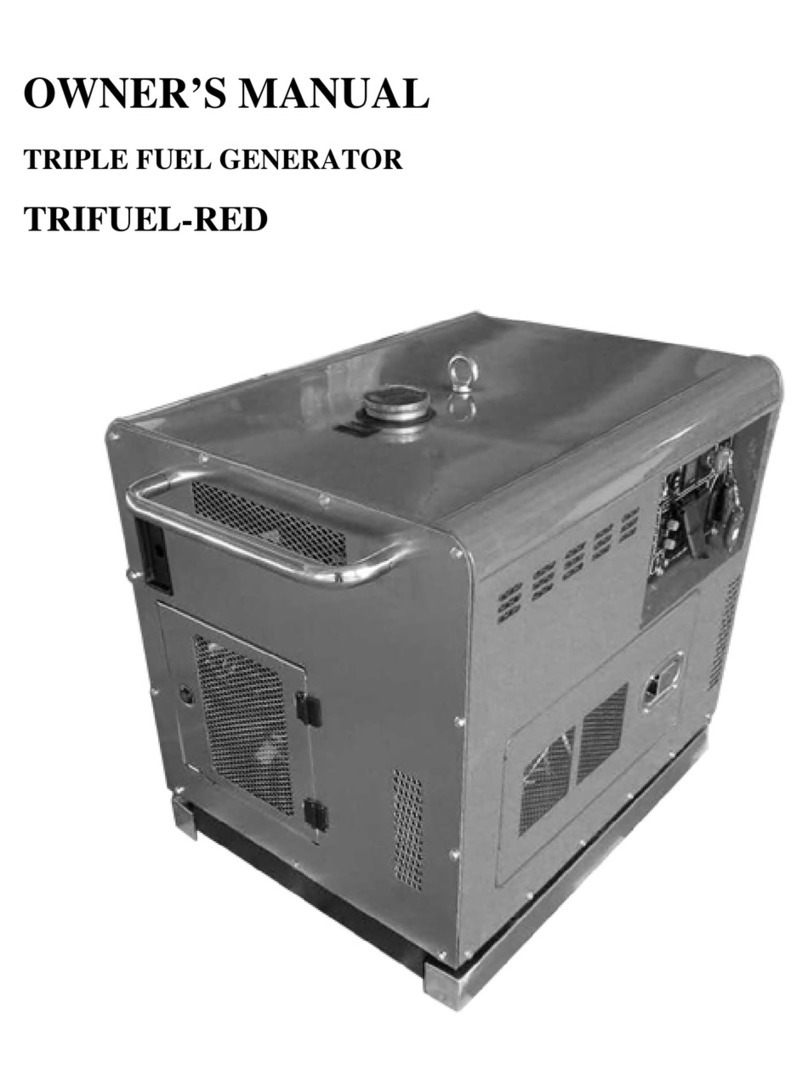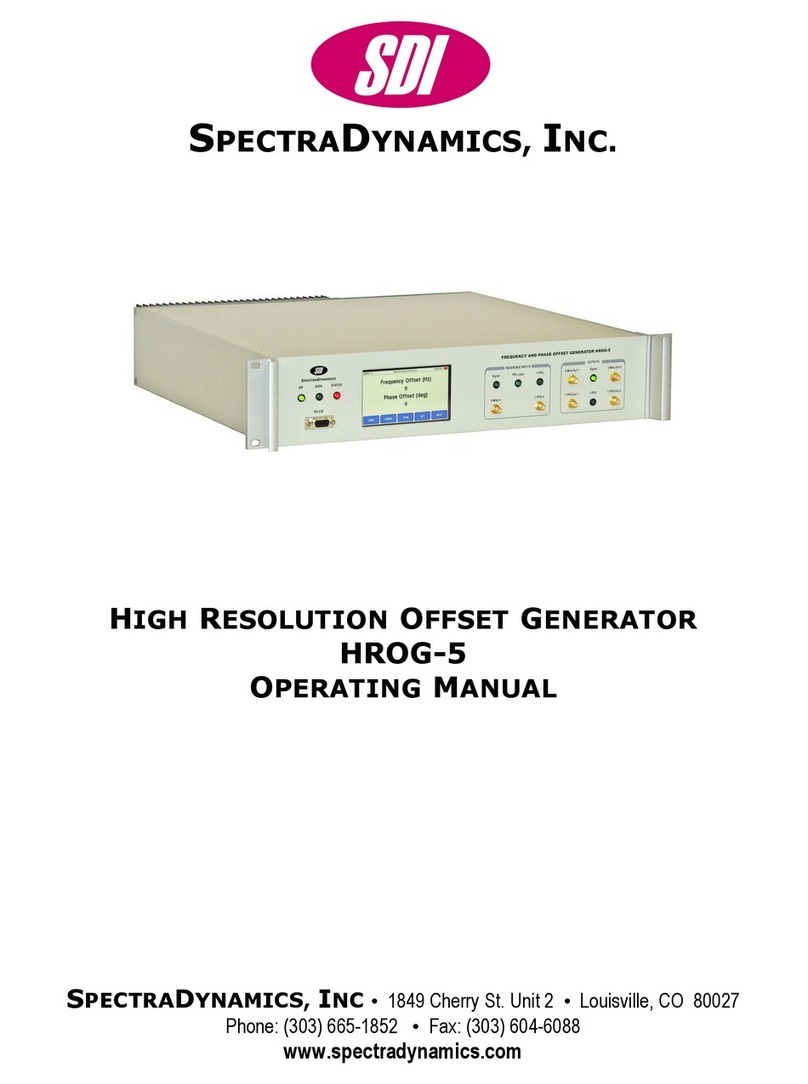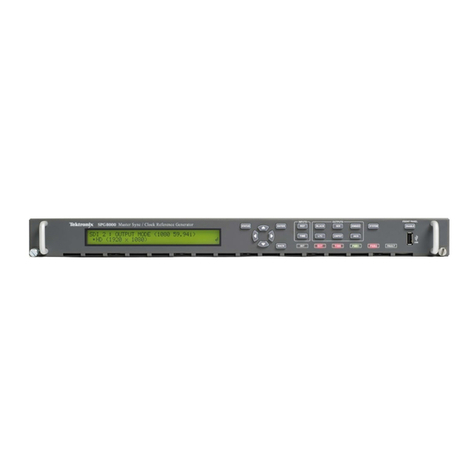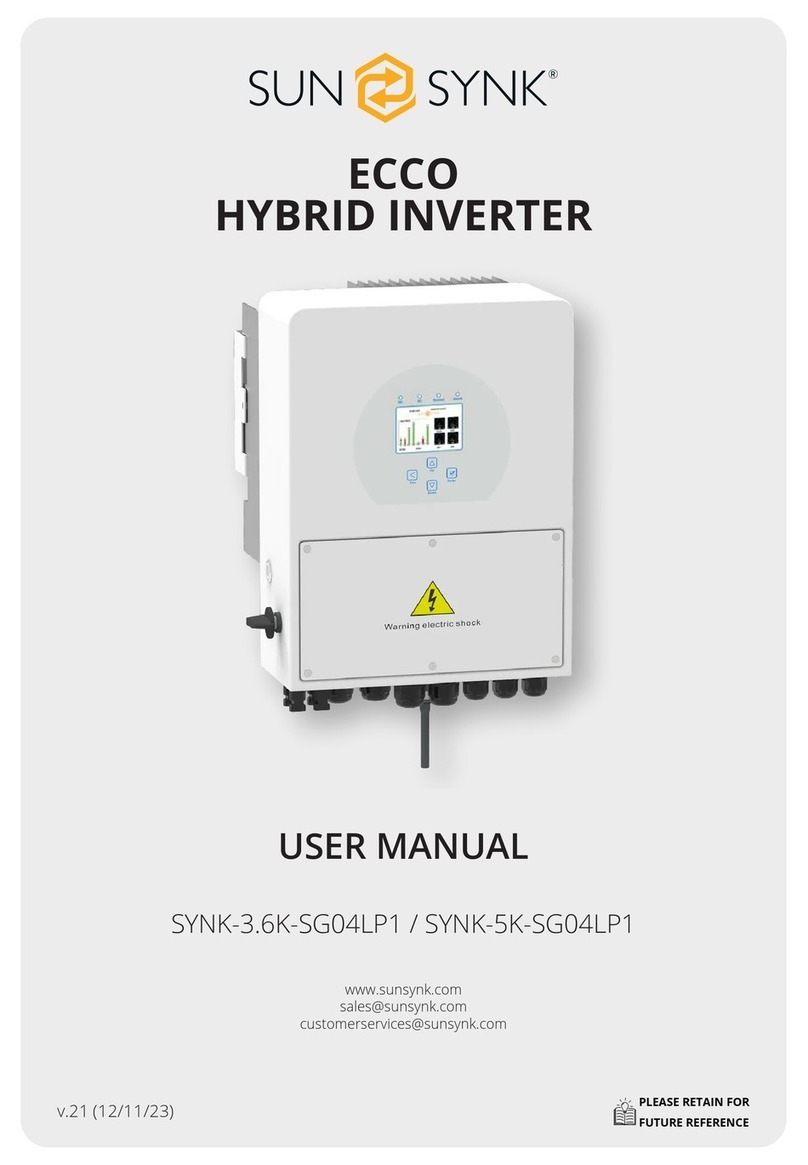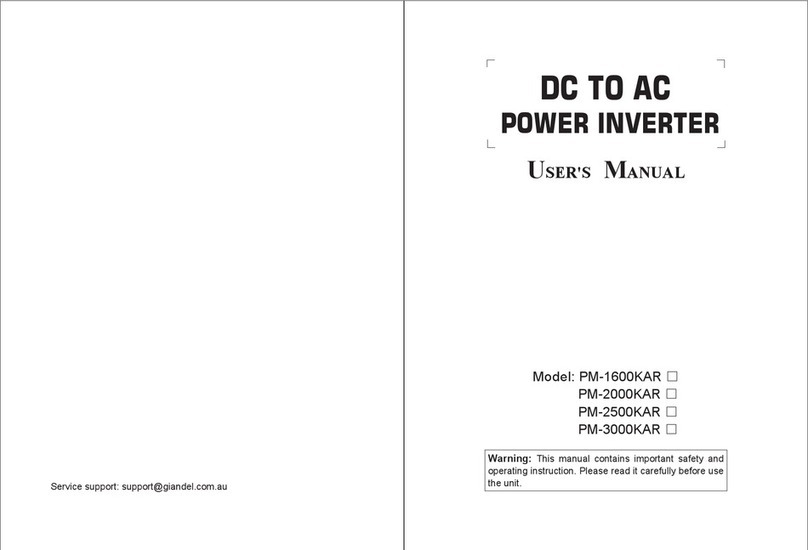TENTEK Tiger Series User manual

User Manual
Tiger Series 2-in-1 Microinveer
600W-1.2KW
Version: 1.0

1. For Sloped Roof
2. For Flat Roof or Ground System
Fault Reference Code
Troubleshooting
Introduction
Validity
Scope
Target Group
Symbols
Safety Instructions
02
02
02
02
03
Features
Real-time Monitoring
Optimal Reliability
Ease of Design
Safety
2 types applications model
Installation Preparation
Module Compatibility
PV Module Selection
Branch Circuit Capacity
Grounding Considerations
Utility Seice Requirements
Lightning and Surge Suppression
Installation
Unpacking and Inspection
Installation Tools
Mounting the Unit
Disconnecting a Microinveer from the PV Module
Installing a replacement Microinveer
Specications
Manual Information
01
01 01
02
03
04
Table Of Contents
04
04
04
04
04
05
06
06
06
06
06
07
07
07
08
08
11
12
13
14
15
16
* Please note that this version will also be modied and updated in the future.

02 02
Manual Information
Validity
This manual is valid for the following devices:
Scope
This manual describes the transpo, installation, operation and troubleshooting of this unit. Please read this manual carefully before installa-
tion and operation.
Target Group
This document is intended for qualied persons and end users. Tasks that do not require any paicular qualication can also be peormed by
end users. Qualied persons must have the following skills:
Symbols
The following symbols appear on the product label and are described here:
2-in-1 Tiger series microinveer : 600W-1.2KW;
Knowledge of how an inveer works and is operated
Training on how to deal with the dangers and risks associated with installing and using electrical devices and installation
Training on installation and commissioning of electrical devices and installation
Knowledge of applicable standards and directives
Knowledge of compliance with this document and all safety information
Symbols Explanation
Caution:hot suace!
DANGER:
Under “Caution, hot suace”, it should be noted that suaces of equipment may be hot and create a burn
hazard.
Refer to manual:
Under “Instructions for Use“, it is pointed out that installation and operating instructions are to be read and
understood before installation or repair.
DANGER:
Risk of electrical shock. Hazardous voltage will cause death or serious inju. Turn o the Power before
working on this equipment.
Refer to safety instructions.
Attention!
With the term “attention” - a circumstance is listed which may cause propey damage if disregarded.
Special disposal instructions!
With “Note Separate Disposal”, it is noted out that this product can not be disposed of with normal garbage.
An improperly conducted disposal can lead to damage to the environment.

03 03
Safety Instructions
WARNING: This chapter containsimpoantsafety and operating instructions. Read and keep this manual for future reference
1. Before using the unit, read all instructions and cautiona markings on the unit, and all appropriate sections of this manual.
2. CAUTION – Only qualied personnel should install, troubleshoot, replace this device or cable and accessories.
3. Before connecting the microinveer to the power distribution grid, contact the local power distribution grid company to get appropri-
ate approvals.
4. It is the responsibility of the installer to provide external disconnect switches and Over Current Protection Devices (OCPD).
5. Do not exceed the maximum number of microinveers in an AC branch circuit as listed in the manual. You must protect each microin-
veer’s AC branch circuit with a maximum breaker or fuse as appropriate.
6. Ensure that all AC and DC wiring are correct and none of the AC or DC wires are pinched, shoed or damaged. Ensure that all AC
junction boxes are properly closed.
7. Be seriously cautious when working with metal tools on or around batteries. A potential risk exists to drop a tool to spark or sho
circuit batteries or other electrical pas may cause anexplosion.
8. Please strictly follow the installation procedure when you want to disconnect AC or DC terminals. Please see the INSTALLATION
section of this manual for the details.
9. GROUNDING INSTRUCTIONS -the PV array should be connected to a permanent grounded wiring system. Be sure to comply with
local standards and regulation to install thisinveer.
10.NEVER cause AC output and DC input sho circuited. Do NOT connect to the main power when DC input sho circuits.
11.Do not connect the microinveers to the grid or energize the AC circuit(s) until you have completed all of the installation procedures
and have received approval from the electrical utility authority.
12. Warning!! Only qualied seice persons are able to see this device. If errors still persist after following troubleshooting table, please
send this Microinveer back to local dealer orseice center for maintenance.
13.Do not disassemble the unit. Take it to a qualied seice center when seice or repair is required. Incorrect re-assembly may result
in a risk of electric shock or re.
14.Toreduce the risk of electric shock, disconnect all wiring before attempting any maintenance or cleaning. Only turning o the unit will
not reduce the risk.

04 04
Introduction
Features:
The TENTEK Tiger series microinveer , can be widely used in general 190V-276V electric power distribution. Each microinveer, with up to 2
PV modules connected, built in quick t connectors, simplies the installation process and ranks among the most cost eective solutions for
commercial and industrial installations.
TENTEK Microinveer individually connects to each PV module in your array. This conguration enables an individual MPPT to control each PV
module, ensuring that maximum power available from each PV module is transmitted to the utility grid regardless of the peormance of the
other PV modules in the array. While an individual PV module in the array may be aected by shading, soiling, orientation, or PV module
mismatch, each TENTEK Microinveer ensures top peormance for its associated PV module.
Real-time Monitoring
Once you install the TENTEK Microinveer and connect your home WiFi successfully, which automatically begin repoing to historical system
peormance trends and informs you about the PV system status.
Optimal Reliability
Microinveer systems are inherently more reliable than traditional inveers. The distributed nature of a microinveer system ensures that
there is no single point of system failure in the PV system. TENTEK Microinveers are designed to operate at full power at ambient tempera-
tures as high as 65 ℃ (149 F).
Ease of Design
PV systems using TENTEK Microinveers are ve simple to design and install. You will not need cumbersome calculations like traditional string
inveers. You can install individual PV modules in any combination of PV module quantity, type, age and orientation. Each microinveer quickly
mounts on the PV racking, directly beneath each PV module.
Safety
Low voltage DC wires connect from the PV module directly to the co-located microinveer, eliminating the risk of personnel exposure to
dangerously high DC voltage.

05 05
2 types applications model:
On-grid working model:
TENTEK Tiger series Microinveers will eciently conve the DC output of the PV module into grid-compliant AC power.
Storage Working Model:
Completing with TENKEK Tribun-EMS controller allows realizing the storage and utilization of solar energy. So as to ensure that some impo-
ant household devices can continue to work in the case of power failure. It also can realize the function of no power feed in grid connection
mode and load caring in o grid mode, so as to meet the self use projects with ceain load capacity. And those projects that cannot apply
for grid connection or whose transformer capacity is limited.
NOTE: To ensure optimal reliability and to meet warranty requirements, the Microinveer must be installed according to the
instructions in this manual
Distribution Board
To Grid
Meter
EarthNeutral
Ground
X
Ground
Distribution Board
Meter
To Grid
Max load power ≤ inverter 1 + inverter 2
1.6KW
EMS Controller
Recommend 24V/100Ah Battery
400-450W Solar Module
PV Input
2 MPPT Trackers
DC
Output
AC
Output
AC Input
EPS Loading
800W Inverter
800W Inverter
BAT
LOAD
ALARM
PV
RUN
Controller
Tribune-EMS
1.6kW

06 06
Installation Preparation
Module Compatibility
TENTEK Tiger series microinveer are compatible with most 60-cell and 72-cell PV modules. For other types of PV modules, please ensure that
they are electrically paired with TENTEK microinveer. Please see the Technical Data page of this user manual to get more information.
PV Module Selection:
When selecting proper PV modules, please be sure to consider below parameters:
Branch Circuit Capacity
Plan your AC branch circuits to meet the following limits* for maximum number of microinveers per branch when protected with a 30-amp
over-current protection device (OCPD). For most multi-phase installations, use a 3- pole32A OCPD.
1. Open circuit Voltage (VOC) of PV modules not exceeding maximum PV array open circuit voltage onveer.
2. Open circuit Voltage (VOC) of PV modules should be higher than minimum batte voltage.
Maximum Microinveers per AC branch circuit
Grounding Considerations
This microinveer is a classy equipment with basic isolation transformer and this microinveer must be eahed. There is an eah wire inside
the AC cable, so usually the grounding can be done by directly by this wire. If the utility has some special requirements, the grounding can be
done by bonding the mounting bracket to the racking.
Items Tiger-600W2E1P Tiger-800W2E1P
32A Maximum over current
protection device (OCPD) 5PCS 4PCS 3PCS 3PCS
Utility Seice Requirements
The microinveers work with single-phase or three-phase seice. Measure AC line voltage at the electrical utility connection to conrm that
it is within range:
Single-Phase Seice Three-Phase Seice
L1 to N 190 to 276VAC L1 to L2 to L3
L1, L2, L3 to N
330 to 478 VAC
190 to 276 VAC
Tiger-1KW2E1P Tiger-1.2KW2E1P

07 07
Lightning and Surge Suppression
TENTEK Microinveers have integral surge protection. However, if the surge has over energy, the protection built into the microinveer can be
exceeded, and the equipment can be damaged. For this reason, TENTEK recommends you to protect your system with a lightning and/or
surge suppression device. In addition, to have some level of surge suppression, it is also impoant to have insurance that protects against
lightning and electrical surges. NOTE: Protection against lightning and resulting voltage surge must be in accordance with local standards.
Unpacking and Inspection
Before installation, please inspect the package. Be sure that nothing inside the package is damaged. You should have received the following
items inside of package:
Precautions :
-The installation must be done with the equipment disconnected from the grid and with the PV modules shaded or isolated.
- Make sure the environmental conditions t the microinveer’s requirement (degree of protection, temperature, humidity, altitude, etc.) as
specied in the Technical Data section.
-Avoid direct sunlight to prevent power derating which can be caused by an increase in the internal temperature of the microinveer.
-Keep the inveer in well-ventilated place to avoid overheating.
-Keep the inveer away from gases or ammable substances.
-Avoid electromagnetic inteerence because it can compromise the normal operation of electronic equipment.
-Install only on structures specically designed for PV modules (supplied by PV modules installer).
-Install microinveer underneath PV modules to make sure it works in the shadow. Nonobseance may cause the derating of inveer produc-
tion.
Installation
The Microinveer x1
User manual x1
Protective end cap x1
Mounting Bracket (adapter plate) x1 with screws x2 (optional)
Extra AC plug and play cable (optional)
Installation Tools
Besides tools recommended below, other auxilia tools can also be used on site like Screwdriver and Multimeter.
Socket Wrench or Allen wrench Marker pen
Diagonal pliers Steel tap
Wire cutters Cable tie
Wire stripper Torque and adjustable wrench
Utility knife
Safety glove Dust masks
Protective goggles Safety shoes

08 08
Mounting the Unit
Tentek Tiger 600-1200W series microinveer already integrated 2.4m Plug and Play AC cable(AC in cable + AC out cable). Please choose a
suitable location and direction for installation
Attention:
Since the space between the solar panel and the roof is ve small, the microinveer should also be parallel to the solar panel and preinstalled
on the rail under the solar panel.
1. For Sloped Roof:
1. Microinveer installation and DC connections must be done under the PV module to avoid direct sunlight, rain exposure, snow buildup,
UV and etc.
2. Leave a minimum of 2 cm of space around the microinveer enclosure to ensure ventilation and heat dissipation.
3. Mounting torque of the 8 mm screw is 9 N·m. Do not over torque.
4. Do not pull or hold the AC cable or PV cable with your hand. Hold the moicroinveer instead.
WARNING:
If your solar array layout like following design or some other irregular layout, you should buy extra Plug and Play AC cable.

09 09
Step 1. Fix the Mounting Bracket (adapter plate) with the microinveer.
Step 2. Mark the right position on the racking system. Evaluate the location of the micro inveer with respect to
the PV module junction box or any other obstructions.
Step 3. Fix the M5 screws on the rail. Hang the microinveer on the screws, and tighten the screws. The silver
cover side of the microinveer should be facing the roof.

10 10
Step 6. Install main combiner box, nish all AC cable’s connection.
Step 4. Connect all microinveer via “AC plug and play cable” , complete the AC Connection.
Note: Make sure that the AC Connectors are kept away from any drainage channels
Step 5. Install AC Branch Circuit Junction Box and Connect AC END Cable.

11 11
Step 8. Install the microinveer directly beneath each PV module and same time connect the PV modules’ DC cables to the
DC input side of the microinveer.
Turn on the AC breaker of each branch system, and the main AC breaker of whole system. Your system will sta to generate electric power in
about 2-3 minutes.
Step 9. Energize the microinveer system
Step 7. Create an Installation Map
Please Peel the removable SN sticker from the backside of each microinveer(as following picture showed), then
ax the SN sticker to the respective location on the installation map.
Microinveer System Installation Map
Solar Station Informatiom Client Installer
Whole system Capacity
Solar panle
Date
Solar pnale Qty
Microinveer Power
Microinveer Qty
PV
Array
C1
L1 L2 L3 L4 L5 L6 L7
C2
C3
C4
C5
C6
C7
Assist installers in identifving the location of each microinveer.
Please Peel the removable SN sticker from the backside of each microinveer, then ax the SN sticker to the respective
location on the installation map.
20kW
450W
40PCS Client Information Installer Information
2KW
10pcs
2023/3/20
SN Sticker

12 12
Attention: The LED light ashed in red last about 1min, then will change into green on.
Step 10. Setup the monitoring system
Refer to the T-shine user manual to install the T-Shine APP and setup your monitoring system

13 13
2. For Flat Roof or Ground System
Attention: Ground the system
The AC cable contains eah wire, so grounding can be done directly with it. For regions that have special requirements, we oer optional
grounding brackets that can be used to complete the external grounding. Route a continuous grounding cable through grounding
brackets for each microinveer to the AC grounding electrode that conforms with local regulations. Torque each grounding cleat screw
to 2 N·m.
Step 3. Install the AC Branch Circuit Junction Box , and main Combiner box
Determine how many microinveers you plan to install on each AC branch and prepare AC Circuit Connectors accordingly.
Step 1. nish solar panels installs rst.
Step 2. Mounting the microinveer on the rail. Since the solar panel is installed at a large distance from the ground, the
inveer can be veically suspended under the rail of the corresponding solar panel. No need extra mounting Bracket
(adapter plate).

14 14
Step 4. Connect all microinveer via “AC plug and play cable” , complete the AC Connection.
Step 5. Complete solar panel connection.
Step 6. Create an Installation Map
Step 7. Energize the System
Please Peel the removable SN sticker from the backside of each microinveer, then ax the SN sticker to the respective location on the
installation map(Same as above Step 7).
Turn on the AC breaker of each branch system, and the main AC breaker of whole system. Your system will sta to generate electric power in
about 2-3 minutes.
LED light display contents
Item Status LED Flashing Remark
Boot initialization
Boot Refresh program
Green
Green
Green
Green
Flash by 1 second
Flash by 0.5 second
Flash by 0.2 second
Boot initialization
APP initialization Red Flash by 2 second APP initialization
APP Waiting Red
Red
Flash by 1 second APP Waiting
APP Running APP RunningFlash by 1 second
APP Fault APP FaultFlash by 1 second
Boot Boot on update, and waiting
for the data transfer
Boot on update, and Refresh
program
1
2
3
4
5
6
7

15 15
Step 8. Set Up Monitoring System
Setup the monitoring system refer to the T-shine user manual to install the T-Shine APP and setup your monitoring system.(same as above
Step 10)
LED light display order:
1:LED light Normal running order:1 4 5 6;
2:LED rlight unning order during the software update:1 2 3 1 4 5 6;
3:LED light running order when update the software during the inveer on running 6 5 1 2 3 4 5 6;
Attention
EMSgrid frequency under
22
23
24
1
2
3
4
5
6
7
8
9
10
11
12
13
14
15
16
17
18
19
20
21
Fault Reference Code
Fault Code Fault event
Grid not available
Grid voltage over
Grid voltage under
Grid frequency over
Grid frequency under
PV1 voltage over
PV2 voltage over
PV1 current over
PV2 current over
output current over
Relay fault
Bus voltage too high
PV1 input reverse connection
PV2 input reverse connection
discharge current over
EMS grid not available
EMS grid voltage over
EMS grid voltage under
EMS grid frequency over
Over loading protection (at o-grid)
Batte voltage is too high
Batte voltage is too low
charge current over
Check main grid connection if ok
Check main grid real voltage
Check main grid real frequency
Check the Voc of each PV module should less than 60V
Check each PV input cable connection,
ensure that there is no looseness
Inspect the AC output cable connection, ensure no looseness.
Inspect the PV input cable and ensure no looseness.
Inspect each pv input ensure no reverse connection
between positive and negative.
What to do
Contact the installer or facto for after sales seice
Stop over loading this devices
Inspect if select the right batte
Inspect if connect the right batte or the batte be discharged.
Check the BMS if on working and the batte setup if right
Not match the right inveer or the inveer overloading
Inspect the main grid switch if turn on
Check the main grid real voltage
Check the main grid real frequency

16 16
1. Check the connection to the utility grid. Verify that the utility voltage and frequency are within allowable range.
2. Verify utility power is present at the inveer in question by removing AC, then DC power. Never disconnect the DC wires while the microin-
veer is producing power. Re-connect the DC module connectors, and then watch for the LED blinks.
3. Check the AC branch circuit interconnection harness between all the microinveer. Verify that each inveer is energized by the utility grid as
described in the previous step.
4. Make sure that any AC disconnects are functioning properly and are closed.
5. Verify the PV module DC voltage is within the allowable range.
6. Check the DC connections between the microinveer and the PV module.
7. If the WIFI signal is weak, it might be due to the distance between the micro inveers and the gateway. It may also be caused by the inteer-
ence from other electronic devices. In most cases, signal quality may be signicantly improved by moving the WIFI router to closer to the micro
inveer arrays.
8. If the problem persists, please call customer suppo at TENTEK.
Troubleshooting
32
33
34
35
30
31
27
28
29
25
26
EMS loading current over
EMS relay fault
EMS communication fault
EMS bus voltage over
Output sho circuited
Solar charger stops due to low batte
EMS PV2 current over
EMS PV2 voltage over
EMS PV1 current over
EMS PV1 voltage over
Fault Code Fault event What to do
EMS PV1, PV2 input reverse protection
Check batte voltage
Check the VOC of each PV string should less than 60V
Check each PV input cable connection, ensure no looseness
Check the total power of home devices, should less than the EMS
rated output.
Need ask the installer or facto to maintain or replace it.
Check the AC connection if looseness
Check the PV1-PV2 input ensure no looseness
Inspect the loading device and output cable if sho connection.
Inspect the each pv input ensure no reverse connection
between positive and negative.

17 17
1. Attach the replacement microinveer to the PV module racking using hardware recommended by your module racking vendor
2. Connect the AC cable of the replacement microinveer and the neighboring microinveer to complete the branch circuit connections.
3. Connect the PV Modules, each Microinveer comes with 2 oppositely sexed DC connectors. First connect the positive DC wire from the PV
module to the negatively marked DC connector (male pin) of the Microinveer. Then connect the negative DC wire from the PV module to the
positively marked DC connector (female socket) of the Microinveer. Repeat for all remaining PV modules using one Microinveer for each
module.
4. Completely install all Microinveers replacement, turn on the branch switch, ensure all inveer on working.
5. update the connection map, aach microinveer has a removable WIFI serial number located on the solar map or the mounting plate. Enter
this WIFI serial number into your station, and correspond it to a number in the connection map.
Installing a replacement Microinveer
WARNING: DO NOT ATTEMPT TO REPAIR THE MICROINVERTER; IT CONTAINS NO USERSERVICEABLE PARTS. IF TROUBLESHOOTING
METHODS FAIL, PLEASE RETURN THE MICROINVERTER TO YOUR DISTRIBUTOR FOR MAINTENANCE.
WARNING: NEVER DISCONNECT THE DC WIRE CONNECTORS UNDER LOAD. ENSURE THAT NO CURRENT IS FLOWING IN THE DC WIRES
PRIOR TO DISCONNECTING. AN OPAQUE COVERING MAY BE USED TO COVER THE MODULE PRIOR TO DISCONNECTING
WARNING: MICROINVERTER IS POWERED BY DC POWER FROM PV MODULES. MAKE SURE YOU DISCONNECT THE DC CONNECTIONS
AND RECONNECT DC POWER TO WATCH FOR THE TWO SECONDS LED ON AND TWO SECONDS LED OFF AFTER DC IS APPLIED.
WARNING: ALWAYS DISCONNECT AC POWER BEFORE DISCONNECTING PV MODULE WIRES FROM MICROINVERTER. THE AC CONNEC-
TOR OF THE FIRST MICROINVERTER IN A BRANCH CIRCUIT IS SUITABLE AS A DISCONNECTING MEANS ONCE THE AC BRANCH CIRCUIT
BREAKER IN THE LOADCENTER HAS BEEN OPENED.
To ensure the Microinveer is not disconnected from the PV modules under load, adhere to the following disconnection steps in the order
shown:
1. Disconnect the AC by opening the branch circuit breaker.
2. Disconnect the rst AC connector in the branch circuit.
3. Cover the module with an opaque cover.
4. Using a DC current probe, verify there is no current owing in the DC wires between the PV module and the Microinveer.
5. Care should be taken when measuring DC currents, most clamp-on meters must be zeroed rst and tend to drift with time.
6. Disconnect the PV module DC wire connectors from the microinveer.
7. Remove the Microinveer from the PV array racking
Disconnecting a Microinveer from the PV Module

18 18
PV Input Data
Number of MPPT Trackers
Suggested Modules Range
Max. Input DC Voltage
MPPT Operating Voltage Range
Startup Voltage
Overvoltage Class DC Port
DC Port Backfeed Current
Max. Input Current
PV Array Requirement
2
60V
25~50V
20V
II
0 A
2 × 18 A
2x1 Ungrounded array; No Additional PV side protection required
AC Output Data
Peak Output Power 1800W 2400W 3000W 3600W
Max. Continuous Output Power
Max. Continuous Output Current
Nominal Output Voltage
Nominal Frequency/Range
Extended Frequency/Range
AC Short Circuit Current
Max. Units Per Branch Circuit
Overvoltage Class AC Port
Power Factor(Adjustable)
Level of Harmonics Distortion
AC Protection Required
600W 800W 1000W 1200W
2.6A 3.5A 4.3A 5.2A
230Vac
50HZ
45~55Hz / 55~65Hz
7.5A
5
III
>0.99 Default, 0.8 Leading...0.8 Lagging...
<3%
AC Output Side Need 63A Circuit Breaker(on grid mode)
Efficiency
CEC Weighted Efficiency
Peak Inverter Efficiency
Static MPPT Efficiency
Night Time Power Consumption
95%
95.50%
99%
<50mW
Mechanical Data
Operating Ambient Temperature Range
Storage Ambinet Temperature
Relative Humidity Range
Connector Type: DC
Dimensions(W*H*D)
Weight
Cooling
Approved for Wet Locations
Enclosure Rating
AC Cable Length(Customizable)
Features
Communication
Monitoring
Compliance
-40 °C to +65 °C(-40 °F to +149 ° F )
-40 °C to +85 °C(-40 °F to +185° F )
4% to 100% (condensing)
MC4
218*245*42mm
4.2KG
Natural Convection-No Fans
Yes
IP67
Standard 2.4m(customized available)
WIFI
Support Remote Web Page Monitoring and Mobile APP by TENTEK Cloud
VDE4105, CE , EN50549...
Model Tiger-600W2E1P Tiger-800W2E1P Tiger-1KW2E1P Tiger-1.2KW2E1P
300W~400W*2 350W~450W*2 400W~450W*2 550W~600W*2
Support off-grid operation and battery mode operation without mains power
Specications

Recycling and disposal
In order to comply with the regulations on recycling management of electrical and electronic wastes in various countries, electrical equipments
that have reached its lifetime must be collected separately to the unit or individual that has obtained the qualication for disposing discarded
electrical and electronic products. For any equipment that you no longer use, please return it to your dealer for recycling, or send it to an
approved recycling unit in your area for recycling.
8th Floor, B-A1, #2 Shihuan Rd, Shiyan Town,Baoan District, Shenzhen,China.
Shenzhen Tentek New Energy Technology Co., Ltd.
www.tentekenergy.com
+86-0755-2301 6478
info@tentekenergy.com
19 19
This manual suits for next models
4
Other TENTEK Inverter manuals

